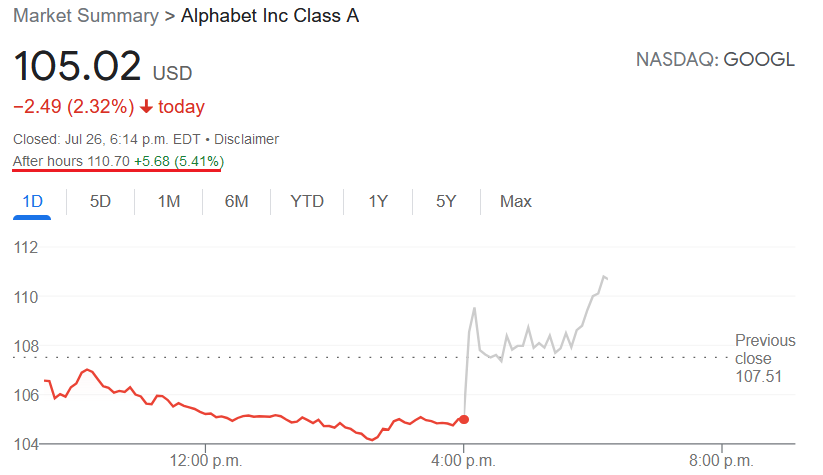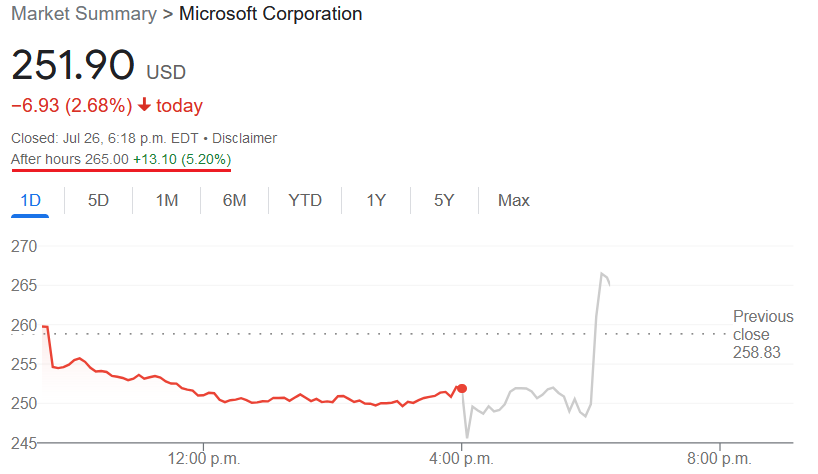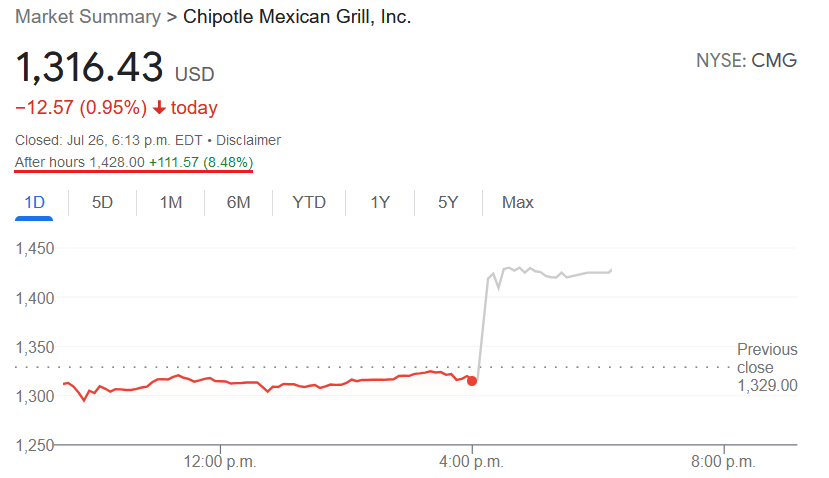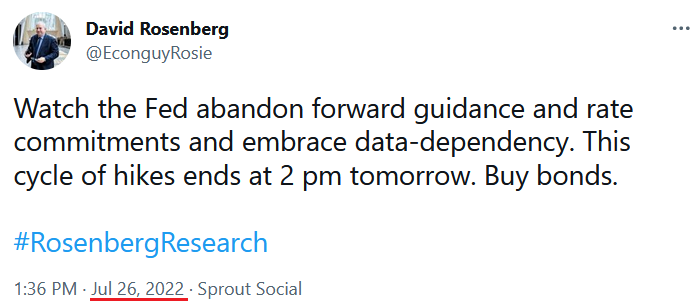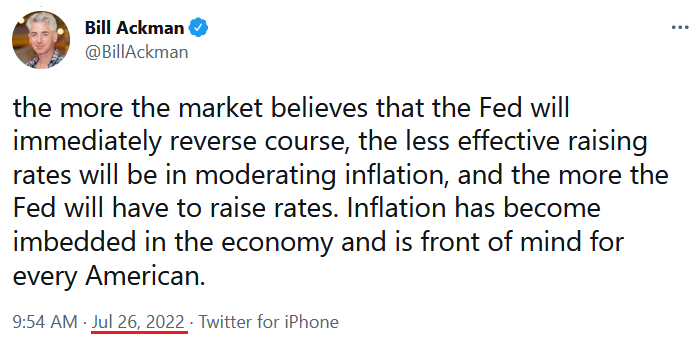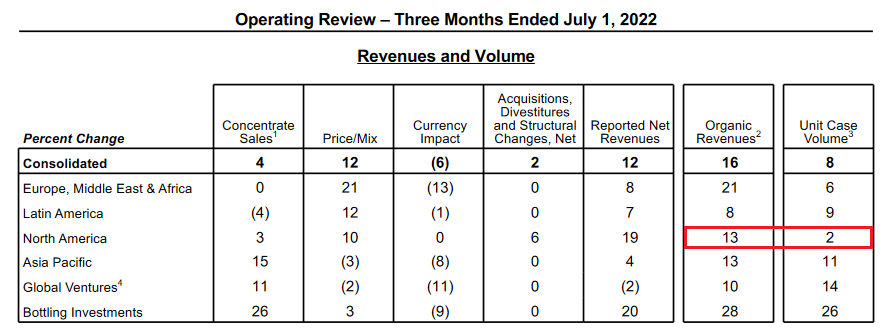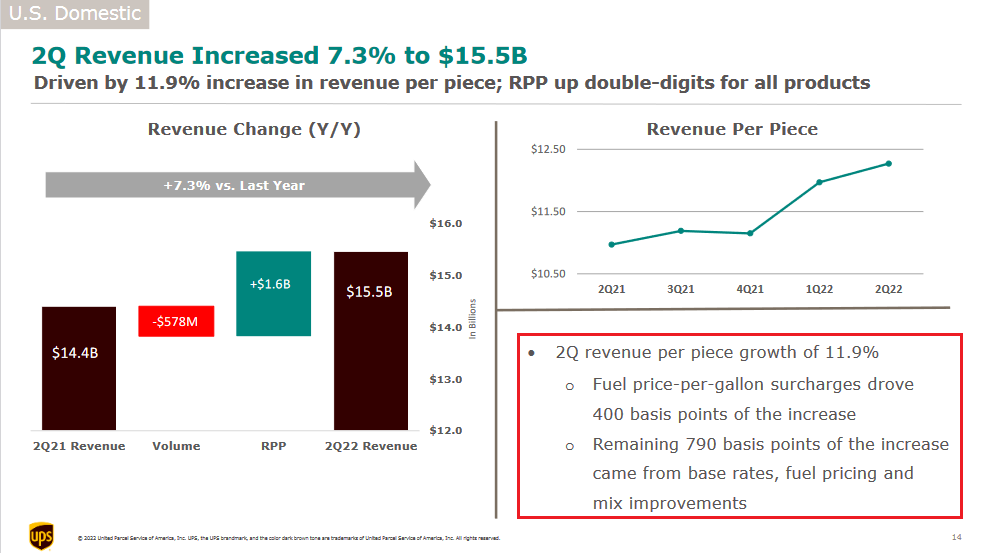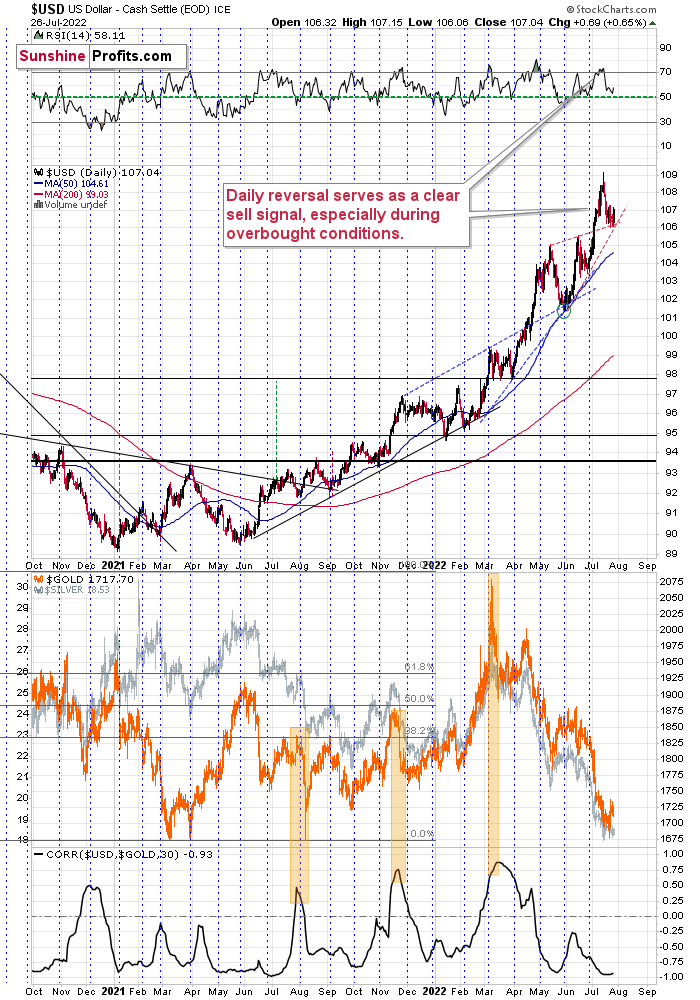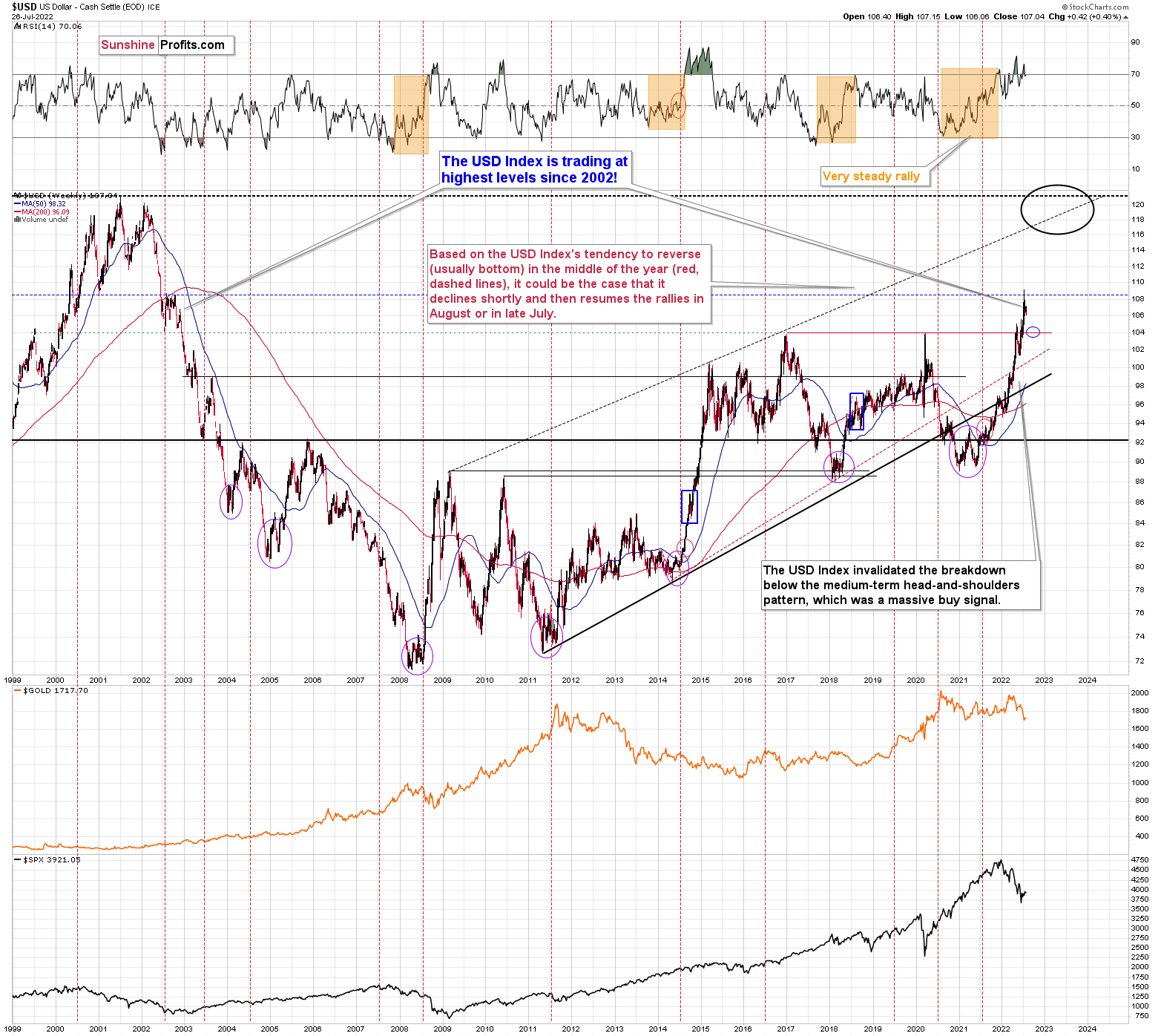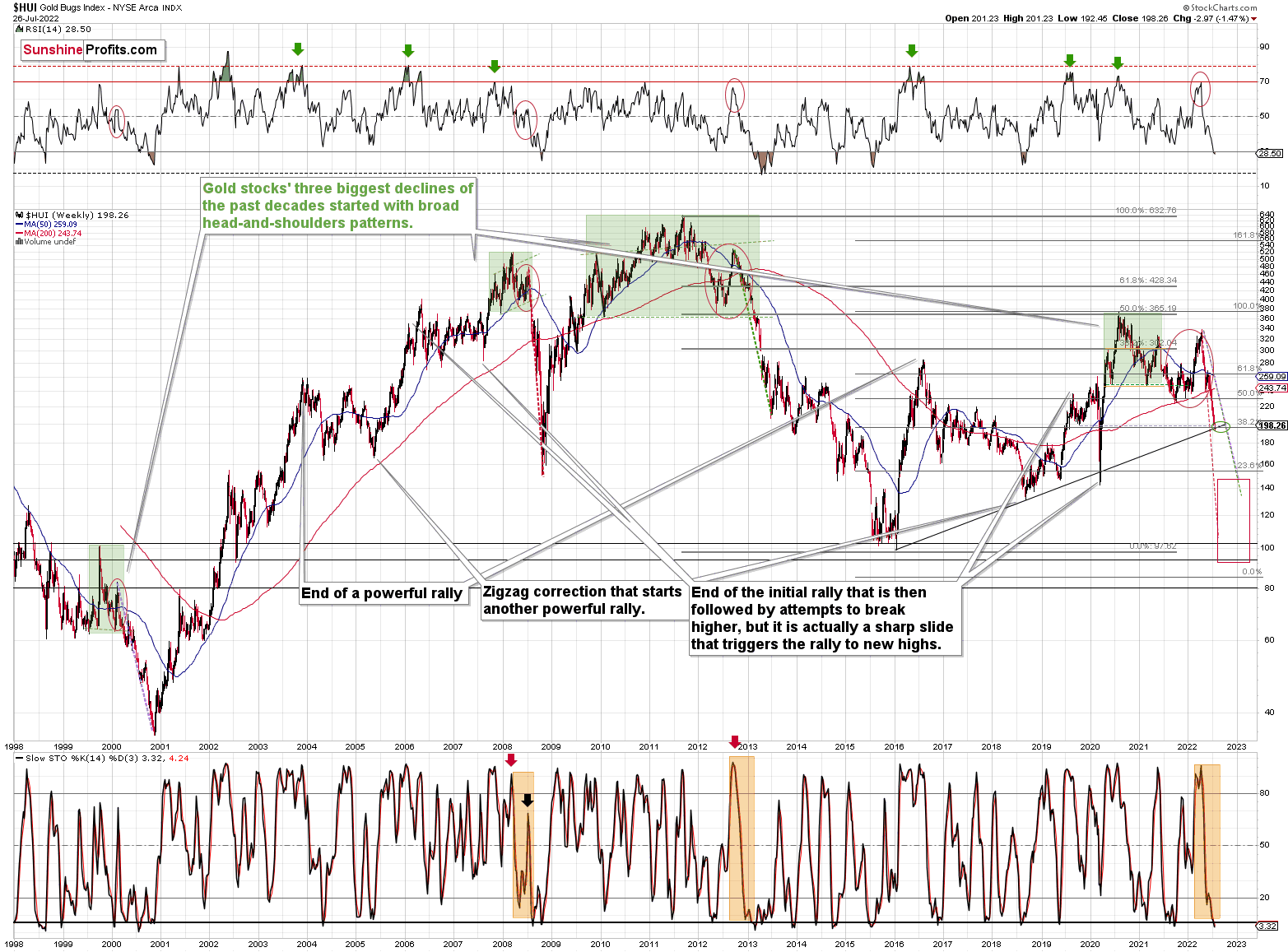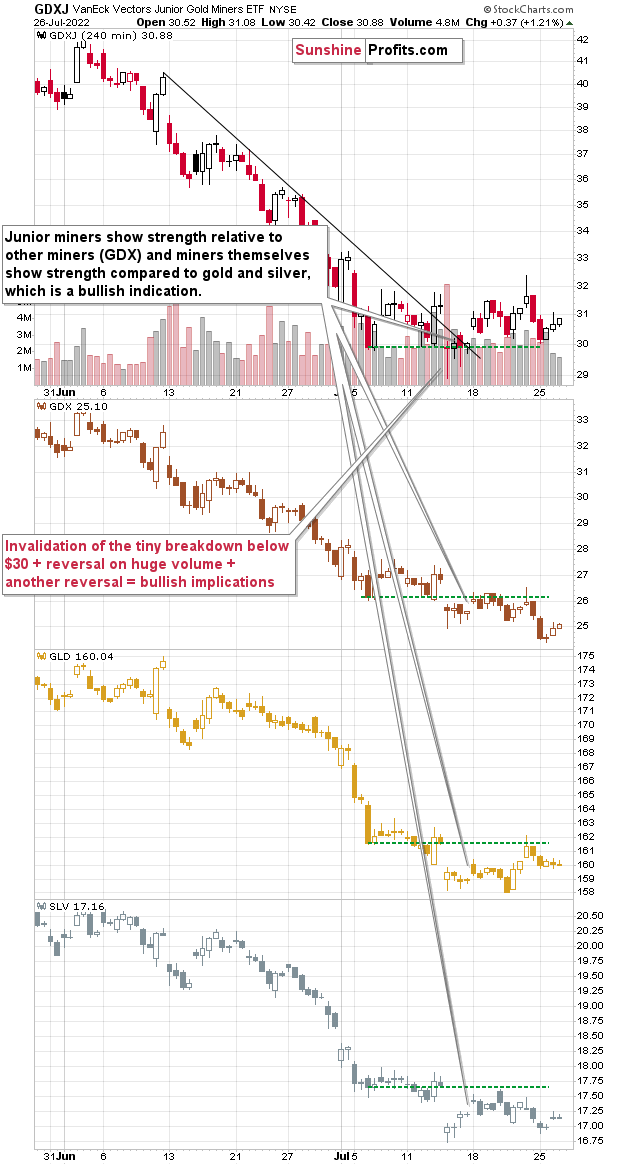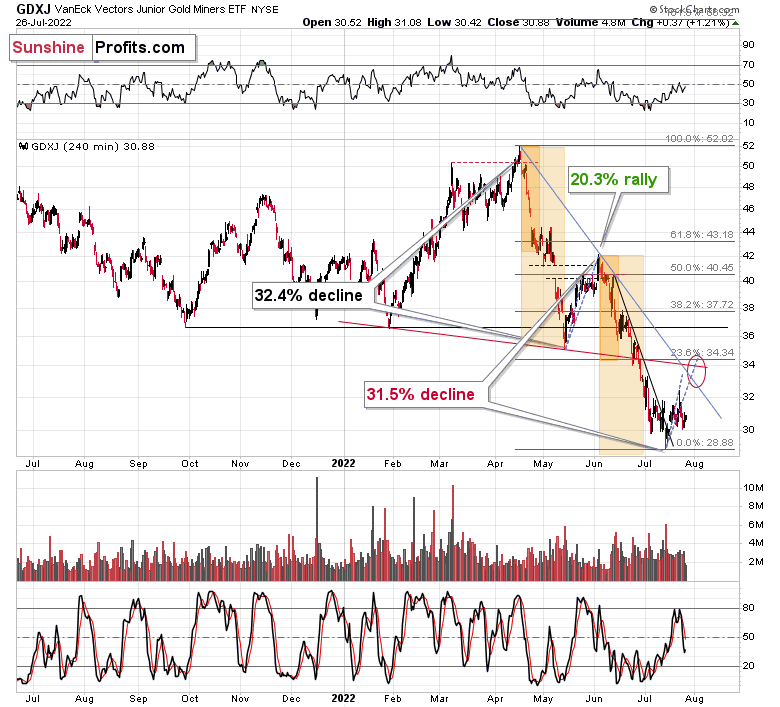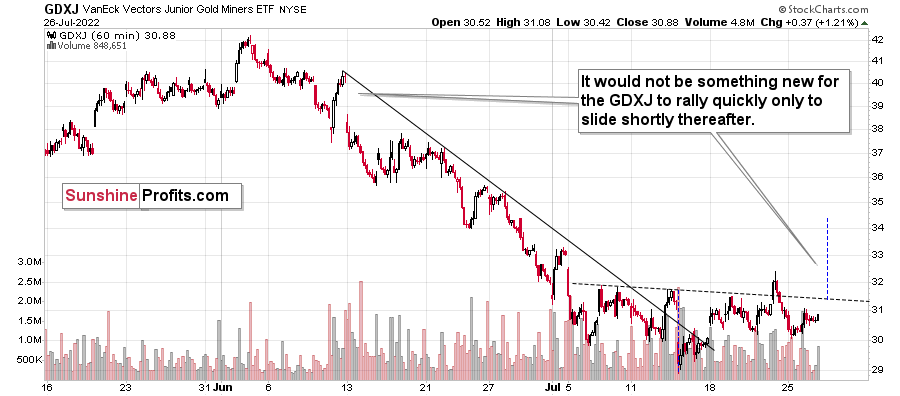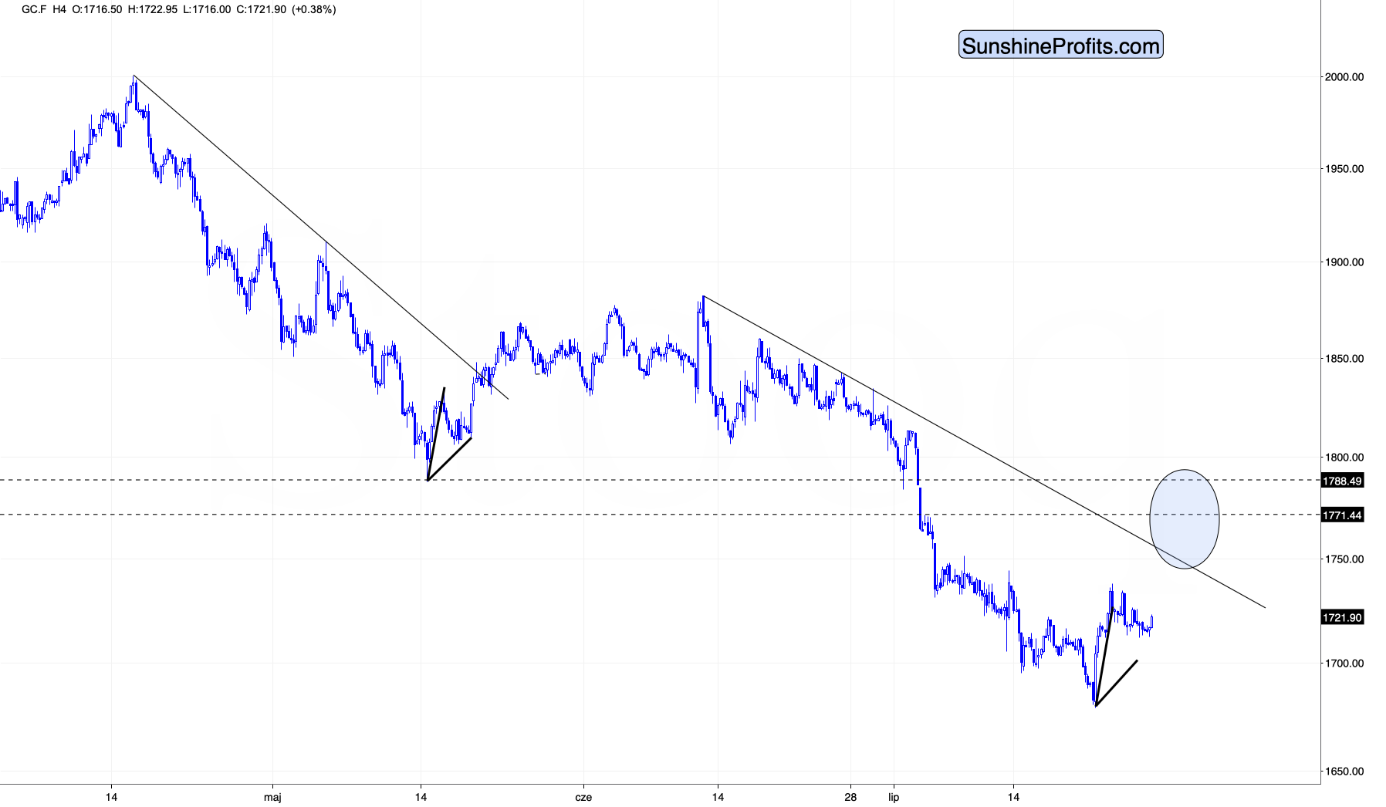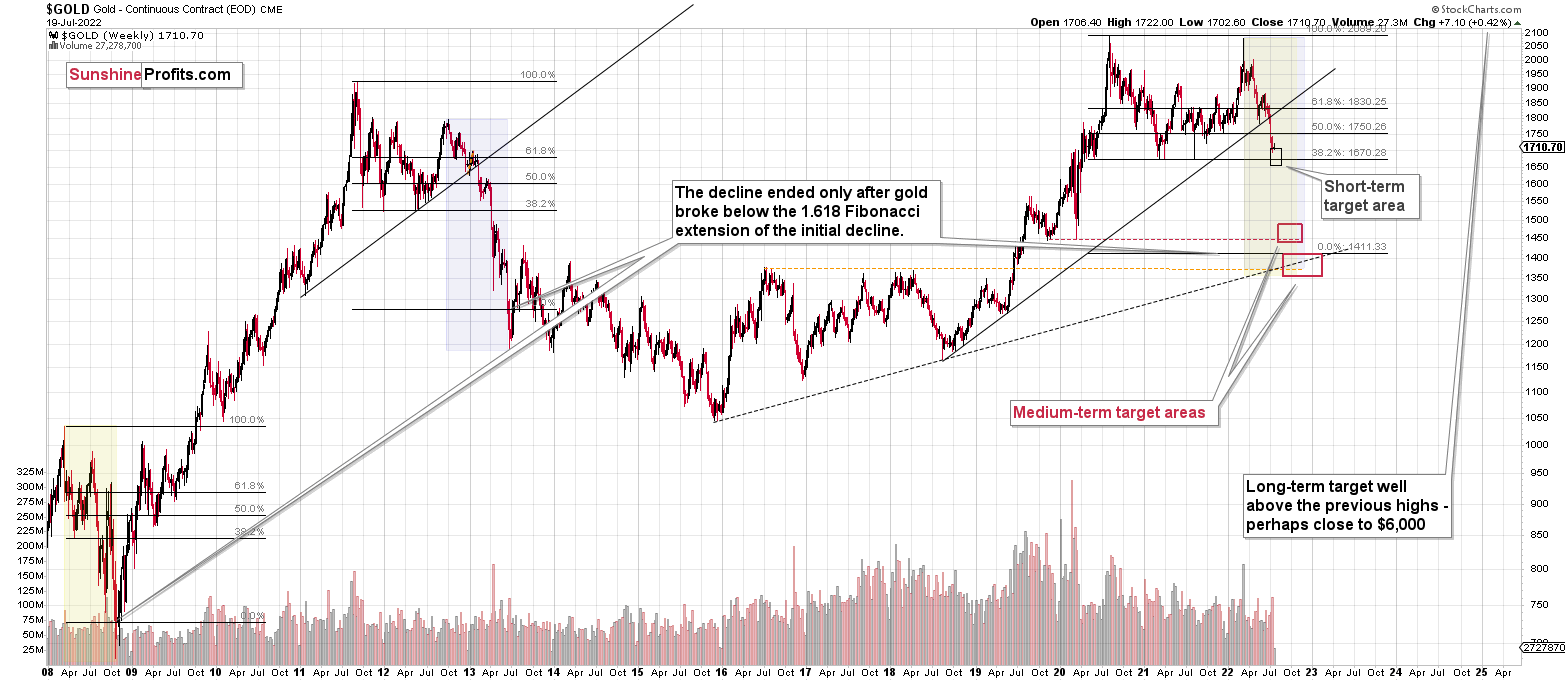Briefly: in our opinion, full (200% of the regular position size) speculative long positions in junior mining stocks are justified from the risk/reward point of view at the moment of publishing this Alert.
Today is the day we get another interest rate decision, so let’s start today’s analysis with a fundamental overview.
Happy Days
While negativity cascaded across the financial markets on Jul. 26, the GDXJ ETF was a material outperformer. Moreover, with resilient corporate earnings flowing in after the bell, the bulls' growing confidence should help uplift the junior miners in the days ahead.
Please see below:
To explain, while Snap Inc.’s collapse had investors fearing an online advertising apocalypse, Alphabet’s spirited results/guidance were met with applause. Likewise, with investors also responding positively to Microsoft’s results/guidance, the ‘less bad is good’ crowd sees fundamental light at the end of the tunnel.
Please see below:
To that point, I noted before the open that extremely depressed sentiment often culminates in reversals, regardless of the fundamental merit. I wrote:
With everyone panicking about rampant inflation and an impending recession, their freak-outs were contrarian bullish. In a nutshell: no one is left to sell when all the bears have sold, no matter how weak the incoming fundamental data. Then, when the shorts cover and systematic funds (CTAs) enter the mix, counterintuitive rallies like the ones we’re experiencing unfold.
However, while the GDXJ ETF hasn’t benefited much from the S&P 500’s relative strength, decent earnings prints from Big Tech (Microsoft and Alphabet report after the bell on Jul. 26) could supercharge investors’ optimism.
Thus, “decent” is the important term. While neither of these Big Tech behemoths outperformed analysts’ quarterly estimates, their results/guidance were better than investors’ worst fears. Therefore, ‘less bad is good.’
Also noteworthy, Chipotle Mexican Grill – which has a nearly $40 billion market cap – also surged after hours on upbeat earnings/guidance. As such, follow-through in the days ahead is bullish for risk assets like the GDXJ ETF.
Place Your Bets
With the earnings picture covered, all eyes are now on today’s FOMC meeting. With the monetary policy committee poised to raise interest rates by 0.75%, the worst-kept secret shouldn’t surprise investors. However, with Chairman Jerome Powell’s press conference poised to move markets, his rhetoric could impact the USD Index, U.S. Treasury yields, and the PMs.
Furthermore, while Powell typically leans dovish during his pressers – which is bearish for the USD Index and bullish for the GDXJ ETF – the final destination of the U.S. federal funds rate will be the most important medium-term fundamental development.
On one side of the coin:
On the other:
Thus, while the chorus grows louder and believes the Fed is approaching the end of its rate hike cycle (futures market expects 3%), billionaire hedge fund manager Bill Ackman has it right: “the more the market believes that the Fed will immediately reverse course, the less effective raising rates will be in moderating inflation, and the more the Fed will have to raise rates.”
As such, while I continue to warn that investors materially underestimate the ferocity of inflation, the counterintuitive nature of Ackman’s comment is spot on: the more the financial markets perceive Powell as dovish, the more hawkish he will have to be in the end. To that point, the U.S. 10-Year real yield and high yield credit spreads have declined in recent days. Moreover, despite the rally on Jul. 26, the USD Index is still down from its highs.
Therefore, financial conditions have loosened recently, and the Fed needs tighter financial conditions to curb inflation. As a result, the consensus is missing the forest through the trees. With financial conditions loosening while the Fed is still hawkish, imagine what will happen if officials preach patience. In a nutshell: real yields will decline, the USD Index will suffer, and the monetary mistake will reverse the small amount of inflation progress that’s been made.
Thus, while trying to guess Powell’s message today is a fool’s errand, the important point is that a hyper-inflationary collapse is much worse than a rate-hike-induced recession; and with inflation still materially unanchored, the 3% U.S. federal funds rate crowd should learn hard lessons over the medium term.
Easy to See
While the financial markets rally on earnings optimism and hopes of a dovish Fed, the current environment supports higher prices for the GDXJ ETF. However, with investors ignoring the medium-term ramifications, warning signs are hiding in plain sight.
To explain, I’ve covered the bullish inflation data from several earnings reports; and with the momentum continuing, the Fed is woefully behind the inflation curve. For example, McDonald’s – the largest restaurant chain in the world – released its second-quarter earnings on Jul. 26. CFO Kevin Ozan said during the Q2 earnings call:
“For the full year in the US, we expect roughly 12% to 14% [input] inflation. It's a little higher than that in the second quarter, likely a little higher than that in the third quarter. And then we expect to see it to moderate some in the fourth quarter. Obviously, that's based on what we know today. That's on food and paper.”
“On the labor side, we're probably seeing a little over 10% labor inflation right now. Part of that is, we had strategic wage rate increases in our company-operated restaurants kind of mid last year. So, we won't start lapping those until the second half of the year. So more of that inflation was hit in the first half of the year than the second.”
As such, how do you expect McDonald’s executives to respond when confronted with this much margin pressure?
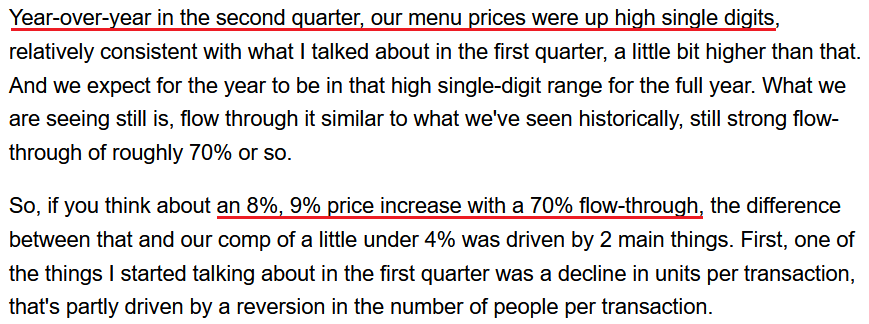 Source: McDonald’s/Seeking Alpha
Source: McDonald’s/Seeking Alpha
Likewise, Coca-Cola – one of the largest beverage companies in the world – released its second-quarter earnings on Jul. 26. CEO James Quincey said during the Q2 earnings call:
“We've been passing through the commodity increases (…). But the commodities are not the majority of the cost base. We've got a lot of service and other inputs, and we are seeing broader-based inflation than just commodities up and down. And so as those come through, we pass them through.”
“And so, we’ve passed a good bit through so far this year. We anticipate more cost increases will come through on a broad-based set of inputs (…). We will continue to pass those through. And what that’s likely to look like in terms of rate is we’ll kind of be at inflation or slightly behind headline inflation as it goes up with the layover of price/mix.”
Thus, with Coca-Cola’s North American organic revenue up by 13% year-over-year (YoY) in Q2, while its unit case volume only increased by 2%, the company raised prices by up to 11%.
Please see below:
Continuing the theme, United Parcel Service (UPS) – one of the largest shipping companies in the U.S. – released its second-quarter earnings on Jul. 26. CFO Brian Newman said during the Q2 earnings call:
“Changes to the price per gallon for fuel drove 400 basis points of the revenue per piece growth rate increase, and the remaining 790 basis points of revenue per piece improvement came from the actions we took, which included base rates, fuel pricing, and mix improvements.”
“Total expenses grew 6.9%, primarily driven by two factors. First, fuel drove 370 basis points of the expense growth rate increase due primarily to the rise in price per gallon compared to last year. And second, wages and benefits contributed about 200 basis points of the increase due to the rise in health, welfare, and pension rates.”
Moreover, he added: "we plan for a $1 an hour increase for our teamsters starting in August," while CEO Carol Tome stated, "If you're a four-year driver here, you're making $14 an hour." Thus, a little math tells us that the average UPS driver should receive a 7% wage increase next month.
As a result, should anyone be surprised that UPS hiked its U.S. domestic shipping prices by up to 11.9% in Q2?
To explain, with volume down by ~4% and revenue up by 7.3%, fuel surcharges and base rates made up the bulk of the difference. As a result, whether Powell knows it or not, the Fed is a long way from solving its inflation conundrum.
The Bottom Line
With Powell taking center stage today, intraday volatility may be amplified. However, with risk assets often rallying during Powell’s pressers, another re-enactment would help our long position. Moreover, if he decides to talk down the USD Index and U.S. Treasury yields, it would only brighten the GDXJ ETF’s short-term outlook. As such, while unanchored inflation should shift sentiment over the medium term, we still expect higher prices in the days ahead.
In conclusion, the PMs were mixed on Jul. 26, as gold ended the day in the red. However, with mining stocks showcasing relative strength in the face of a stock market sell-off, the outperformance should have more room to run. Therefore, we remain bullish for the short term, while remaining very bearish for the following weeks/months.
Technically Speaking
The fundamental background provides a good basis for what’s been likely to happen for some time now. Namely, that we’re going to see a short-term upswing that’s followed by a bigger downswing.
The upswing could be triggered by Powell’s dovish remarks, and the following downswing (that would start in a couple of days or so – or maybe earlier) could be caused by people realizing that regardless of what Powell said and how dovish it seemed, they will ultimately keep hiking interest rates, and that they might need to do so at a faster pace than the market currently expects.
Does it fit the technical picture? Yes, it does.
First of all, the above would fit the scenario in which the USD Index declines briefly and bottoms very close to the end of the month – for example, on Friday or Monday.
This would be in perfect tune with USDX’s tendency to form reversals (usually) bottoms at the turn of the month (or close to it – as visible on the above chart), and also – from a broader point of view – in the middle of the year.
It would also perfectly fit the signal that we just saw in the HUI Index.
In yesterday’s analysis, I commented on the above chart in the following way:
Namely, the gold stocks moved slightly below their Fibonacci retracement and the rising, long-term support line. The latter was broken only once previously. It was in early 2020, and when that happened, a very sharp rally followed practically immediately. Will we see the same thing this time? That’s quite likely. However, I don’t think the rally would be that significant.
Consequently, it could be the case that we’re going to see more strength in the precious metals market before the big move lower continues.
Indeed, the flagship proxy for gold stocks invalidated its small breakdown below its rising long-term support line, which served as a short-term buy signal.
The GDXJ ETF – a proxy for junior miners – rallied by 1.21% yesterday, which means that it rallied more than it had declined the previous day, when Newmont’s decline triggered declines in the GDX ETF and HUI Index.
Since the GDXJ is up over 2% in today’s London trading (while gold futures are up by just 0.25%), it seems that its outperformance of the rest of the precious metals sector hasn’t ended yet.
It remains likely that the GDXJ ETF moves higher in the very near term, likely topping close to one of its declining resistance lines. One of those lines is based on the previous tops (the blue line) and the other (the red line) is the neck level of the previously broken head and shoulders pattern.
When we zoom in even more, we see that sudden upswings are not that uncommon in the case of junior miners.
We saw one in early June. If gold jumps higher on dovish remarks from the Fed, juniors would be likely to jump, too.
The resistance line based on the previous July highs could be viewed as a neck level of an inverse head-and-shoulders pattern, which – when broken – would support a rally to the $34-34.5 area.
Gold’s intraday picture also supports such a quick upswing.
Based on the symmetry of how gold recently performed after a local bottom (sharp rally and then a correction), it seems that we’re on the verge of a sharp move higher.
The black lines that I marked on the above chart are identical – I copied the previous lines connecting the bottom with the following top and bottom, and I pasted them on the current situation, attaching them to the recent bottom. Interestingly, the timing of the recent immediate-term top and bottom aligns almost perfectly. This makes it quite likely that the follow-up action will also be similar.
Please note that just because the about-to-be-seen rally is likely to be sharp, doesn’t mean that it’s likely to be a medium-term game-changer. To clarify, a $30-80 rally is what I think is likely to follow, nothing more. The $1,745-$1,770 area seems to be the most reliable short-term target in my view.
As always, I’ll keep my subscribers informed.
Overview of the Upcoming Part of the Decline
- It seems to me that we’re going to see a corrective upswing here (probably ending in the final week of July or very early August) that will then be followed by a very big decline in the precious metals sector.
- If we see a situation where miners slide in a meaningful and volatile way while silver doesn’t (it just declines moderately), I plan to – once again – switch from short positions in miners to short positions in silver. At this time, it’s too early to say at what price levels this could take place and if we get this kind of opportunity at all – perhaps with gold prices close to $1,600.
- I plan to exit all remaining short positions once gold shows substantial strength relative to the USD Index while the latter is still rallying. This may be the case with gold close to $1,400. I expect silver to fall the hardest in the final part of the move. This moment (when gold performs very strongly against the rallying USD and miners are strong relative to gold after its substantial decline) is likely to be the best entry point for long-term investments, in my view. This can also happen with gold close to $1,400, but at the moment it’s too early to say with certainty.
- The above is based on the information available today, and it might change in the following days/weeks.
You will find my general overview of the outlook for gold on the chart below:
Please note that the above timing details are relatively broad and “for general overview only” – so that you know more or less what I think and how volatile I think the moves are likely to be – on an approximate basis. These time targets are not binding nor clear enough for me to think that they should be used for purchasing options, warrants, or similar instruments.
Summary
Summing up, it seems that while the medium-term trend in the precious metals sector remains down, we are likely to see a corrective upswing soon. Based on the confirmations that we have seen recently, the short-term outlook is bullish.
In my opinion, the GDXJ will most likely move higher and top sometime this week – perhaps close to the Fed’s interest rate decision.
It seems likely that the profits that we earned from the last couple of trades will increase even further in the near future.
After the final sell-off (that takes gold to about $1,350-$1,500), I expect the precious metals to rally significantly. The final part of the decline might take as little as 1-5 weeks, so it's important to stay alert to any changes.
As always, we'll keep you – our subscribers – informed.
To summarize:
Trading capital (supplementary part of the portfolio; our opinion): Full speculative long positions (200% of the full position) in junior mining stocks are justified from the risk to reward point of view with the following binding exit profit-take price levels:
Mining stocks (price levels for the GDXJ ETF): binding profit-take exit price: $33.87; stop-loss: none (the volatility is too big to justify a stop-loss order in case of this particular trade)
Alternatively, if one seeks leverage, we’re providing the binding profit-take levels for the JNUG (2x leveraged). The binding profit-take level for the JNUG: $36.78; stop-loss for the JNUG: none (the volatility is too big to justify a SL order in case of this particular trade).
For-your-information targets (our opinion; we continue to think that mining stocks are the preferred way of taking advantage of the upcoming price move, but if for whatever reason one wants / has to use silver or gold for this trade, we are providing the details anyway.):
Silver futures upside profit-take exit price: $20.28
SLV profit-take exit price: $18.78
AGQ profit-take exit price: $24.57
Gold futures upside profit-take exit price: $1,776
HGU.TO – alternative (Canadian) 2x leveraged gold stocks ETF – the upside profit-take exit price: $13.46
HZU.TO – alternative (Canadian) 2x leveraged silver ETF – the upside profit-take exit price: $9.18
Long-term capital (core part of the portfolio; our opinion): No positions (in other words: cash)
Insurance capital (core part of the portfolio; our opinion): Full position
Whether you’ve already subscribed or not, we encourage you to find out how to make the most of our alerts and read our replies to the most common alert-and-gold-trading-related-questions.
Please note that we describe the situation for the day that the alert is posted in the trading section. In other words, if we are writing about a speculative position, it means that it is up-to-date on the day it was posted. We are also featuring the initial target prices to decide whether keeping a position on a given day is in tune with your approach (some moves are too small for medium-term traders, and some might appear too big for day-traders).
Additionally, you might want to read why our stop-loss orders are usually relatively far from the current price.
Please note that a full position doesn't mean using all of the capital for a given trade. You will find details on our thoughts on gold portfolio structuring in the Key Insights section on our website.
As a reminder - "initial target price" means exactly that - an "initial" one. It's not a price level at which we suggest closing positions. If this becomes the case (as it did in the previous trade), we will refer to these levels as levels of exit orders (exactly as we've done previously). Stop-loss levels, however, are naturally not "initial", but something that, in our opinion, might be entered as an order.
Since it is impossible to synchronize target prices and stop-loss levels for all the ETFs and ETNs with the main markets that we provide these levels for (gold, silver and mining stocks - the GDX ETF), the stop-loss levels and target prices for other ETNs and ETF (among other: UGL, GLL, AGQ, ZSL, NUGT, DUST, JNUG, JDST) are provided as supplementary, and not as "final". This means that if a stop-loss or a target level is reached for any of the "additional instruments" (GLL for instance), but not for the "main instrument" (gold in this case), we will view positions in both gold and GLL as still open and the stop-loss for GLL would have to be moved lower. On the other hand, if gold moves to a stop-loss level but GLL doesn't, then we will view both positions (in gold and GLL) as closed. In other words, since it's not possible to be 100% certain that each related instrument moves to a given level when the underlying instrument does, we can't provide levels that would be binding. The levels that we do provide are our best estimate of the levels that will correspond to the levels in the underlying assets, but it will be the underlying assets that one will need to focus on regarding the signs pointing to closing a given position or keeping it open. We might adjust the levels in the "additional instruments" without adjusting the levels in the "main instruments", which will simply mean that we have improved our estimation of these levels, not that we changed our outlook on the markets. We are already working on a tool that would update these levels daily for the most popular ETFs, ETNs and individual mining stocks.
Our preferred ways to invest in and to trade gold along with the reasoning can be found in the how to buy gold section. Furthermore, our preferred ETFs and ETNs can be found in our Gold & Silver ETF Ranking.
As a reminder, Gold & Silver Trading Alerts are posted before or on each trading day (we usually post them before the opening bell, but we don't promise doing that each day). If there's anything urgent, we will send you an additional small alert before posting the main one.
Thank you.
Przemyslaw Radomski, CFA
Founder, Editor-in-chief


